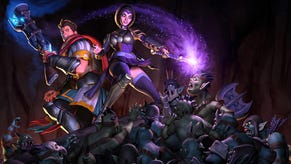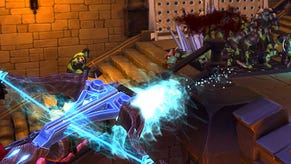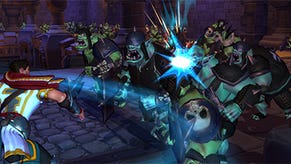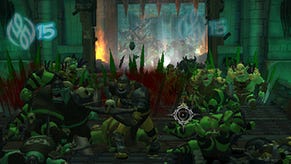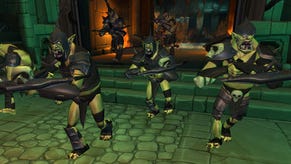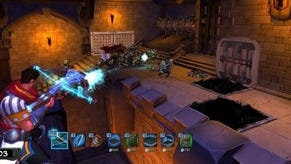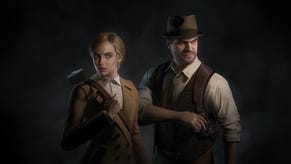Greenocide: Hands-on With Orcs Must Die
Dan has been out in Dallas seeing what Robot Entertainment (risen from the ashes of Ensemble) are up to. They're up to Orcs Must Die, and Dan got to play it.
It’s so easy to stereotype people. For example, everyone is always saying John’s a terrible healer. But if you need someone to provide a sop for your spiritual wounds... then he’s only a mostly awful healer. And he never claimed to be a good healer. AND no-one else here is much better; Alec thinks a field dressing goes on a salad. Likewise, it would be easy to stereotype Robot Entertainment. One might assume that they, having only recently been Ensemble Studios (the erstwhile progenitors of Age of Empires), would love doing even more minutely-researched, accurate strategy games as soon as they shook off the dead hand of Microsoft. One, if I may take the liberty, is dead wrong.
Instead, we have Orcs Must Die, an action tower defense game, which I’m playing in their studio in the dusty sprawl of North Dallas, Texas. On the screen in front of me is a great castle door, nailed shut. It’s bowing and shaking from repeated blows from the other side and the damage being done to its hinges makes my inner carpenter wince. I turn my mage to look around the fortress I’m supposed to be defending against the Orc hordes; it’s very World of Warcraft, all monolithic cobbles, swinging chandeliers and clear pathways all the way up to the cartoony castle’s core, where a rift to the green fields of home lies. No point putting this off any more, I think; and open the door.
It bursts apart. Immediately, twenty or so hulking Orcs warriors bound towards me. I back off, headshotting a few with my magic crossbow and, while that’s reloading, the remainder hit the first of my traps. It flips them sideways against the wall, where they land in the second trap; a delightfully warming pool of tar (Mammoths Not Included). The grunts are looking stunned as they stagger stickily out of that, which must be why they don’t notice the rotary saws. Bits of Orc, looking curiously like roast boars from Asterix, gib everywhere, heads bouncing with startled expressions. I let the remaining few (who aren’t picked off by my Elven Archer ally) get within a few feet of me before I cast a wall of fire. They sizzle like pork sausages and fall down before I have to even draw my sword.
So, yeah. Not really Age of Empires.

Chris Rippy, producer of OMD (and whose biography lists his interests as “pizza and sandwiches”) implies that this game-changing decision wasn’t really about breaking with the past, more that this wasn’t something they’d had an opportunity to do at Microsoft. “In the history of Ensemble, we've wanted to do a bunch of different things but none of them came out in the past. With this, there were a bunch of us playing Horde mode and defence games and we prototyped this out of merging those.”
It’s certainly a big change; the anarchy of the Orcs mixes with the cartoon dungeon look to give something partway between Dungeon Keeper and World of Warcraft, rather than the more architectural Age of Empires design. “Classical fantasy gives us a grounding” says Rippy “People know how these creatures behave; they know that a little runner goes really quickly through the world, and you should respond accordingly. With this, we can make Orcs funny, then slice them up; that makes us happy.” Even the music is a departure from Age of Empires, throwing out heavy metal with riffs for combos and headshots.
Anyway, you take the part of The War Mage, the least powerful, most stubborn and most stupid apprentice in the realm. At the moment he’s also the last surviving wizard in the realm, who’s been left to defend all the rift fortresses by himself against the limitless encroaching Orc hordes. Playing as him, the basic mechanic is of collecting resources from killing enemies (with big bonuses for combos, mixing up traps and melee) and using them to build more traps, ranging from pop-up floor spikes, to giant swinging balls and corridors of arrows. Your aim is to defend the dungeon heart, ahem, the rift against the attackers; though you instantly respawn, your own death also substantially weakens the heart, as do enemies getting through.

So far, we’ve seen four types of enemy, though the developers assure us there will be at least eight; they fit the Tower Defence stereotypes, with the plebian orcs and orc archers making up the meat of most battles whilst the tiny, weak runners sprint ahead, triggering the slow-resetting traps and the lumbering ogres absorb everything you throw at them. They also have their own specialities; ogres can’t be flipped, runners are too fast for many traps, and certain orcs won’t even stop to fight you. It was hinted to us that there will be flying enemies too, and other enemies immune to certain traps.
Like all tower defence games, apart from the traps, weapons and spells you unlock as you go through the game, the key variation of the levels is in their layout. Later levels have multiple entrance points and exit points, necessitating a variety of Heath Robinson / Rube Goldberg layouts to flip and direct the enemies into your killing zones. There are also a range of built-in environmental hazards, such as rolling logs or chandeliers, which you can trigger, and even mannable turrets, to mix up how you kill the enemies. Finally, because the levels are designed in three dimensions, certain placeables, like your static Elven Archers, can affect large parts of the map if placed correctly.
Beyond the combinations of traps, however, I was starting to feel like there wasn’t enough room for customisation and replay in the game; after all, in traditional tower defence you can individually level up turrets, unlock new ones and so on. Rippy disabused me of that idea;: “We have a system that comes on about halfway through that lets you customise how you want to play the game... There’s an entire tech tree and, not to overstate, but it really does give you a chance to make the game how you want it, because there are people who want to get in there hand-to-hand and there are people who want to stand up on a balcony and watch the mousetrap work. It’s exciting but one of the bigger challenges has been balancing all that out.”

For Robot’s first title, this isn’t particularly complex, and as I’m playing a wishlist of extra content is running through my head; multiplayer, PvP, co-op, map editors, downloadable content, and so on. Rippy reads my mind; “We wanted it to be tight, first. We’re a really small team; Our approach on every aspect is if we can’t do it really, really well, let’s not do it at all. When people look at this, they’ll see a lot of depth and polish, especially for a downloadable game. The thing is with this kind of game, you can put it out and take back the feedback, and change things depending on what the community like.”
This isn’t the only title Robot are working on; they’ve just finished off their last project for Microsoft, Age of Empires Online, but after that they’re going down the Double Fine route of producing as many self-published, downloadable games as they can. We’re told that two more projects are in the early stages of development, but they’re just focussed on getting OMD out for now. “We’re aiming for smaller games. Halo Wars was a four or five year project and we can't take that risk. We want more games, on a faster cadence, on a bunch of different platforms... We don't have a five year plan worthy of the Soviets. We come up with ideas that people here get excited about, and have potential creatively and economically; after that, our aim is just global domination.” And, after all, isn’t that everyone’s?

